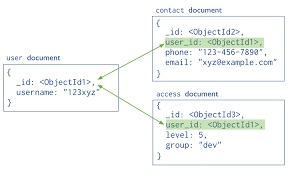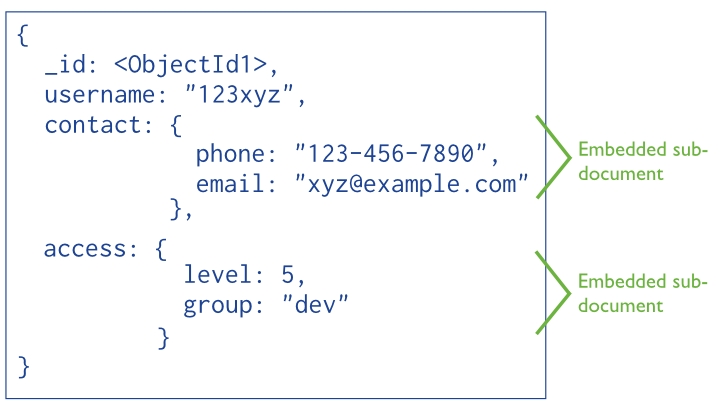Mongoose Associations
Learning Objectives
By the end of this lecture students should be able to:
Understand the difference between embedding and referencing in MongoDB
Know how to implement a one-to-many association in Mongoose using both embedding and referencing
Know how to use the
populate()method to access referenced documents
Introduction
Now that we have Mongoose in the mix, we can see how to make one-to-many and many-to-many relationships with our data in MongoDB. We previously saw how to embed and reference other data from our documents in the MongoDB shell. This is the basis of data "relations" in MongoDB but we will now learn how Mongoose can help us make this process even easier.
Background
Normalized vs. Denormalized Data
What is data normalization? It is a set of rules that we use when creating and relating data so that we do not have orphaned or duplicate data. Putting it simply, a normalized data set should have no redundant data, while a denormalized data set can have some duplicate data.
References vs. Embeds
Referenced Data
References create relationships between data by storing references to one document inside of another. Applications can resolve these references in multiple queries to access the related data.
Here we see an example of a couple of documents that each hold a reference to a separate document. You could say that these exhibit normalization because linked data is referenced, and not duplicated.

Embedded Data
Embedded documents create relationships between data by storing related data in a single document structure. MongoDB documents make it possible to embed document structures in an array field within a document. These denormalized data models allow applications to retrieve and manipulate related data in a single database operation, at the cost of some duplicated data.

Modeling One-to-Many Relationships with Embedded Subdocuments
A document embedded inside of another document is called a subdocument. The easiest and probably most common way to create a one-to-many association using Mongoose is through embedding.
Let's consider an example. With this approach we embed schemas within schemas. Let's consider a BlogPost schema that has many Comments:
Emdedding documents using Mongoose:
In our model file for BlogPost we would define both the blogPostSchema and the commentSchema which will be embedded into the BlogPosts. We only need to make the model for the Parent. We use square brackets [<Schema Name>] to denote that many comments are in a single BlogPost.
Below, is how you add an embedded document to an array:
We can treat post.comments as an array and use the Mongoose push method to push an embedded document into its parent document. We must save the parent document in order for the embedded document to be saved.
Subdocument IDs
Mongoose is super-nice and automatically adds IDs to each of our embedded subdocuments. This makes it very easy to find specific ones for showing, updating or deleting. Mongoose even provides a handy id() function built onto subdocuments that we can use to find one:
The remove method removes child documents. Above, we are locating a BlogPost by whatever value is in myId and then we are finding its subdocument with the ID of subId and removing that subdocument.
Code-Along: Create Embedded Schemas
Code it!
Modeling One-to-Many Relationships with Document References
Consider the following example that maps Product and Order relationships. The example illustrates the advantage of referencing over embedding to avoid repetition of the products information.
The orderSchema has an array of products but we include both a type and a ref. The type will usually always be mongoose.Schema.Types.ObjectId since it will be storing another document's ID. The ref is the name of the referenced model which will be used to help gather data for us as we will soon see.
Quiz: What is our one? What is our many?
This is how we would use referencing:
It's pretty much the same flow that we did with embedded documents but this time we use the child model to actually create a new child object. Instead of simply pushing values into the parent's array, we are pushing a whole saved database object. Mongoose reads this and inserts only the _id column of the referenced document into the parent's array. If we were to query for a single order we would get back the following:
That's not very useful to a human. However, Mongoose knows how to get at the data with that ID very easily.
Populate
In order to obtain the referenced documents we need to call populate on the query.
Let's look at this code. We start by finding an Order by its ID. Normally, there we would use a callback since findById() is an asynchronous function. However, we can't put the callback there if we want to use populate(). You pass in only the id to findById() and then immediately chain the populate() function. It takes the name of the field to populate as a string. Strangely, populate() doesn't take a callback argument and so we must chain exec() which let's us add a callback. But the populate() function does all the magic.
When we put this line in our orderSchema above...
...we told Mongoose that 'Product' was the name of the model to use when populating.The populate function follows your reference to the linked data in the second document and retrieves all of the data in there that is related to your first document. Using populate we can save ourselves the additional queries needed to retrieve all referenced documents. Below we see our products have automatically been included as if they were embedded:
Code-along / Lab: Create Referenced Schemas
Code it!
When to Embed? When to Reference?
Here are some guidelines to consider when deciding on referencing vs embedding from the MongoDB docs:
For performance and simplicity reasons, lean toward embedding over referencing.
Prefer the reference approach when the amount of child data is unbounded and there is a danger of exceeding the 16MB size limit for a document - an uncommon situation however - the entire body of work of Shakespeare can be stored in 5 megabytes!
Prefer the reference approach when multiple parent documents access the same child document and that child's data changes frequently. This avoids having to update redundant data in multiple locations.
Obtaining referenced documents requires multiple queries by your application instead of a single query when using embedding - this is why embedding is much more performant.
Mongoose simplifies the multi-query process for getting data from referenced documents with the populate() function.
In the references approach, depending upon your application's needs, you may choose to maintain links to the related document's _id in either document, or both.
Last updated
Was this helpful?